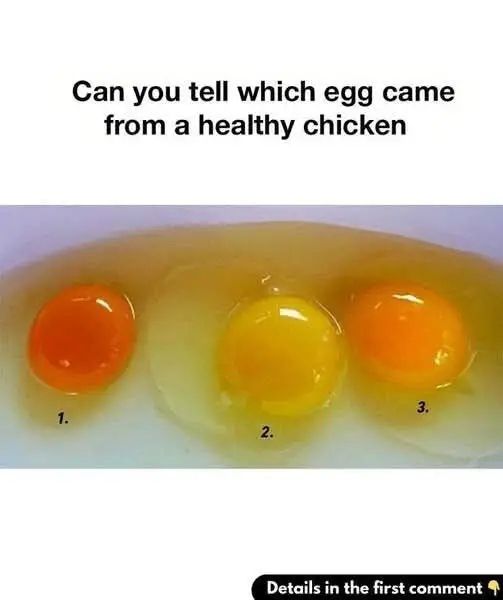🍳 How to Tell If an Egg Came from a Healthy Chicken: 6 Signs of Superior Quality
Eggs are a kitchen essential—affordable, protein-packed, and endlessly versatile. But when you crack one open, have you ever wondered just how healthy the chicken was that laid it? Not all eggs are created equal. The quality, nutrition, and even taste of an egg can vary widely depending on the chicken’s diet, environment, and overall well-being.
Let’s crack into the details and learn how to spot the tell-tale signs of an egg from a healthy, well-cared-for chicken.
🟠 1. The Color of the Yolk
One of the most obvious indicators of egg quality is yolk color. A deep orange or rich golden yolk often signals that the egg came from a healthy chicken with a diverse, natural diet. Pasture-raised hens that forage for grass, bugs, and seeds consume carotenoids, which naturally deepen the yolk’s hue.
In contrast, a pale yellow yolk likely comes from a factory-farmed chicken fed a monotonous, grain-heavy diet with minimal access to sunlight or fresh forage.
💡 Pro Tip: The richer the yolk color, the more nutrients like vitamin A, D, E, and omega-3s it’s likely to contain.
🥚 2. The Thickness and Strength of the Eggshell
Healthy chickens produce strong, thick eggshells. These shells form when hens get enough calcium, phosphorus, and vitamin D—usually through a balanced, natural diet and sunshine exposure.
If an eggshell feels brittle, thin, or fragile, it may mean the hen was nutrient-deficient or stressed, which can compromise the overall egg quality.
💡 Tap Test: Gently tap two eggs together. A strong, healthy shell will give a solid clink, while a weaker one will sound hollow or may even crack.
🥄 3. The Consistency of the Egg White
A fresh, healthy egg should have a thick, jelly-like egg white that holds its shape around the yolk. This means the egg is both fresh and laid by a healthy chicken. If the egg white is runny or watery, the egg may be older—or the hen may have been undernourished or sick.
💡 Check It Out: Crack an egg onto a flat plate. A high-quality egg will have a tall, firm yolk surrounded by a tight, cohesive white.
📏 4. Uniform Size and Shape
Although size varies by chicken breed, consistency is key. Eggs from healthy hens typically have a uniform shape and a smooth shell texture. Misshapen or unusually small eggs can indicate stress, illness, or overcrowding in hens.
💡 Look For: Smooth, evenly shaped eggs without unusual bumps, ridges, or discoloration.
🌤️ 5. Living Conditions of the Chicken
Happy hens lay better eggs—literally. Chickens that roam freely outdoors, forage naturally, and bask in the sun produce healthier, tastier eggs. Conversely, hens kept in cramped cages or unsanitary indoor conditions often suffer from stress, poor diets, and disease, resulting in lower-quality eggs.
💡 Label Language: Look for eggs labeled:
- “Pasture-raised” – Best option; hens have ample outdoor space.
- “Free-range” – Some outdoor access, but not always pasture.
- “Organic” – Fed organic, non-GMO diets and raised without antibiotics.
👃 6. Smell and Taste
Fresh eggs from healthy chickens have a clean, neutral smell and a rich, creamy flavor when cooked. If your egg smells off, has sulfuric notes, or tastes bland or metallic, it may be old—or from an unhealthy bird.
💡 Storage Tip: Keep eggs refrigerated and use within 3–4 weeks. To check freshness, place an egg in a bowl of water—fresh eggs sink, while older eggs float due to expanding air pockets inside the shell.
🧡 Why Egg Quality Matters
Choosing eggs from healthy chickens isn’t just about flavor—it’s about nutritional value and supporting better farming practices. Higher-quality eggs tend to have:
- More omega-3 fatty acids
- Higher levels of vitamins A, D, and E
- Better taste and texture
- Lower risk of contamination or disease
🧑🍳 Bonus Recipe: Perfect Scrambled Eggs Using High-Quality Eggs
Now that you know how to spot the best eggs, put them to work with this foolproof scrambled eggs recipe that celebrates their natural richness.
🥘 Ingredients:
- 2–3 pasture-raised eggs
- 1 tablespoon butter (or olive oil)
- Salt and pepper to taste
- Optional: fresh herbs like chives, parsley, or dill
👨🍳 Instructions:
- Crack the eggs into a bowl and whisk gently until yolks and whites are just combined—don’t overbeat.
- In a nonstick skillet over low to medium heat, melt the butter until it foams.
- Pour in the eggs and let them sit undisturbed for a few seconds, then gently stir with a spatula from the edges inward.
- Continue to stir occasionally until soft curds form and the eggs are barely set. Remove from heat—they’ll continue cooking slightly.
- Season with salt, pepper, and herbs just before serving.
💡 Pro Tip: Cook low and slow for the creamiest texture. High heat toughens proteins and ruins that silky finish.
🥚 Final Thoughts: Choose Eggs That Do More Than Just Crack Right
When you learn to recognize signs of a high-quality egg, you’re not only choosing better food for yourself—you’re also supporting ethical, sustainable farming that puts animal welfare first.
So next time you’re at the store or farmers market, look beyond the price tag. Let your yolks be golden, your shells strong, and your tastebuds delighted. Because good eggs come from happy hens.
Would you like a printable version of this article or a downloadable infographic showing how to spot quality eggs? I can make that for you too!
